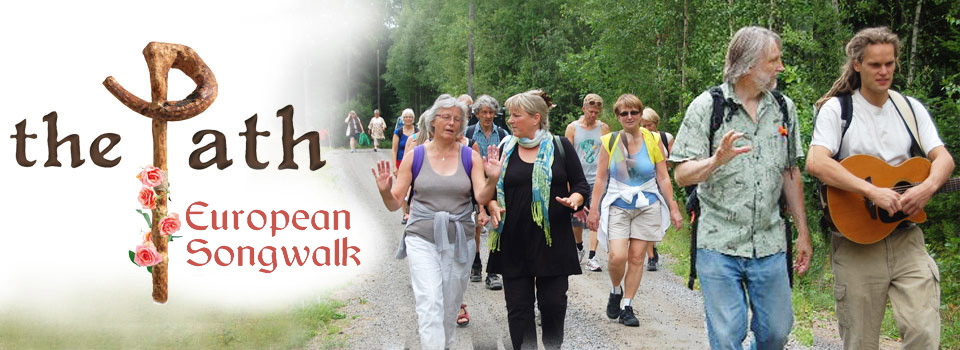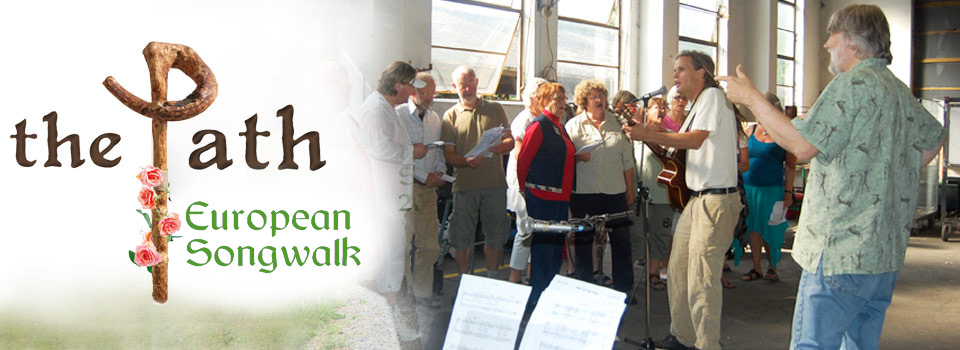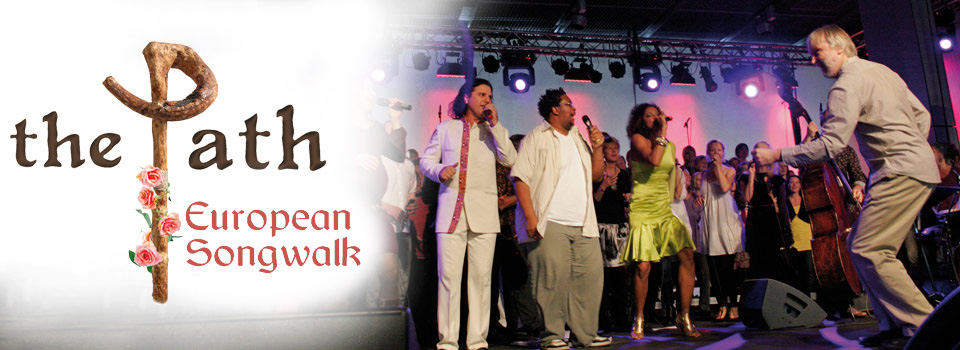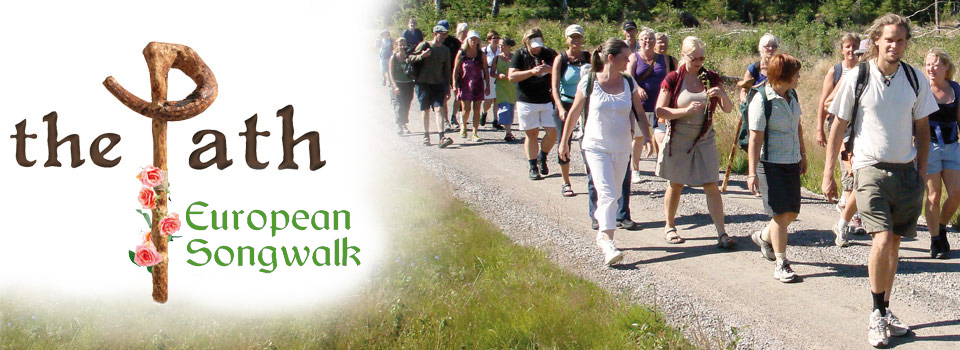Blog
In the blue berry-mountains
The staff walks on. It has travelled in my friends Anders Claesson’s and Peter Elmberg’s confident hands, along lake Vättern and via Jönköping up into the Southern Swedish Highlands. The rain – and indeed the “Class 1 – warnings” from the meteorologists – have kept on showering this summer, but the reports from the walkers have been sunny and warm.
Maybe it is one of the big paradoxes for us walkers to meditate on: when you are in the flow on the path, in the proximity of Nature – or maybe even better in communion with nature – you are able to receive a rainfall as a blessing rather than as the curse we often perceive when we sit indoors in our safety looking out.
*
I have travelled up to Dala-Floda to give attention to house and family. But I have to admit that the walk is nothing you leave behind as you would a wet raincoat. I am still very much in that energy, and the desperate cries from the garden to be seen and attended to, calls I any other summer would find hard to ignore, I now give a cold shoulder rather unfazed.
I surely wouldn’t feel totally free to invite friends and neighbours to a garden party, let alone a magazine to do a ”home and garden-feature”, but so far I have succeeded pretty well to shrug off the loving remarks from the other family members for this summer’s lack of gardening initiatives. I have instead spent a few days at the family’s ”fäbod”, the little traditional hut in the forest where our ancestors would go over the summers in
the semi-nomadic lifestyle of yesteryears. That feels OK for now. The soul is not yet ready to settle. I have to stay in quarantine on the ”fäbod” still a while…
the semi-nomadic lifestyle of yesteryears. That feels OK for now. The soul is not yet ready to settle. I have to stay in quarantine on the ”fäbod” still a while…
The blue mountains serve as a temporary screen, embracing and defining, providing temporary safety. But their blue veils are at the same time urging me to seek what lies behind.
On my way home through the forest after a sharp bend on the small gravel road I all of a sudden see three cars on the wayside. They stand so close I first think it is an accident and I stop, pull down the side-window and ask the group of people moving around the cars if I can offer some help. Three kind, but a bit lost and bewildered faces look in through the window. None speaks Swedish or English but I reckon they understand my good intentions cause they respond eagerly with similarily positive bodylaguage and gestures.
But yes, they know one Swedish word:
”Blåbär!” [Blueberry!]
They look inquisitively at me. I open my empty hands and shrug. It is no year for blueberries this year it seems, and they respond to my gesture with a similar motion. I try to explain that it probably is still to early for blueberries, but I am not sure I am understood.
It is peculiar with human communication. You can read out a lot from so little. And so fast. With or without words. But most important is the will to understand. You always will see what you want to. The manuscript of the so called reality that is played out on your retina is written before the film is rolling. We are the scriptwriters of our own lives. That is exciting and challenging. And really leaves no room at all for blaming somebody else. No one else has access to the writing of the script. We can always change the script. And we do all the time. As long as we live we develop and all the time we change the script. But we are all the time responsible for how we choose to see the world and it is that will that creates the world we perceive. The light is not going outside in, it is projected inside out, not only on the screen on the local cinema but also on the cinema of life.
Already the way they parked their cars and the way they press their heads through the side-window tell of a culture where the private sphere is a lot smaller than we are used to. Translated into Swedish body-language it is very easy to misread. There was no ”car-accident”. As little as their attitude is ”pushy”, ”invasive” or ”offensive”. We see what we choose to see. That sets up and creates the whole story.
”Where do you come from?” I ask. No one understands. But after a bit of sign language they get it.
”Bulgaria!”
”Hmm!”
I think of Wille Thoors, the fiddler, wizard, and fellow Malung-musician, one of the true originals that I have had the pleasure to meet. He glady and often spoke about his travels through Europe with Romani orchestras. If I only had had a fiddle and could have played some gypsy melodies, the fellowship would have been total. If Wille’s stories were anything to go by I would be invited for food and lodging and they would have offered me to their daughters…
The most important thing is how you choose to see. But thereafter it is important to have an instrument to play on. It could be the language, but not necessarily. It could be really anything and if the will is there the instrument will appear in your hand pretty immediately. Of course I know of no better instrument than the music itself and maybe it is the image of the ultimate means of communication; the preferred means of expression for angels and spheres alike. For us to practice on down here in the valleys of death. Irrespectively of what instrument we try to play.
I get at flash-back from my time in South-Africa during the eighties. The country was virtually totally segregated between black and white and the all-inclusive racial war was imminent, yes had already started in
certain areas. But in this polarised environment the music gave me a passport to the townships, a protection of sorts in all the vulnerability and a language that allowed me to share everything essential with those whom I did not share a common spoken language. It was a language that gave me a feeling of significantly
greater fellowship and communication with those I did not share a spoken language with, than with those I did.
certain areas. But in this polarised environment the music gave me a passport to the townships, a protection of sorts in all the vulnerability and a language that allowed me to share everything essential with those whom I did not share a common spoken language. It was a language that gave me a feeling of significantly
greater fellowship and communication with those I did not share a spoken language with, than with those I did.
They look a bit pleadingly in to the car. They are at the mercy of wind and weather in a world they do not know, a world they have no experience of, where they try to survive. They have been enticed to come to the other corner of Europe, to a far, foreign forest. Not unlikely is the stomach, as well as the petrol tank and the wallet, starting to run on empty. And no blueberries in sight despite of the promises. And now they stand here and gaze
into my car.
into my car.
I quickly call to mind other groups who have travelled hungry through this forest, the ”finnforest” which already in the 16th century was populated by hungry immigrants. I think about those who are here now and those who are about to come. Down in the valley I saw the first Somali immigrants ever. They will by all likelihood become more numerous. Sweden has previously not accepted passports from relatives to Somali immigrants as the land has ”collapsed” and their passports are not deemed valid by our authorities. But now they have opened the door to allow DNA-testing as a way of proving ties with already immigrated Somalis.Outside the Swedish embassies of Kenya and Ethiopia and other countries where refugees are gathering the queues to the DNA-tests are long.
I think about the connection with The Path’s two first themes: Environment and Integration. Somalia is topping the list of ”Failed states index”, a classification of the collapsed or collapsing states of the world. Not surprising the list is topped by 5 countries in or around the Sahel-region; Somalia, Congo D.R., Sudan, South-Sudan and Chad. A spreading desert in combination with growing populations can not lead to anything but a political collapse. Also the piracy outside of Somalia’s coast has an environmental cause. The local fishermen who previously were enjoying fishing in one of the world’s richest maritime havens have been pushed aside by big international fishing-fleets who vacuumed the seas and seabeds of its marine resources. In the wake of a collapsed state and with no more fish to catch the small local fishingboats are left with with few other options to make a living than to try to catch the big ships instead.
Maybe not totally illogical, if even immoral.
I am thinking about how to end this blog-post. By writing that I close my car window and go down to the village to buy cheap immigrant-food to still my own hunger?
Or by telling about the farewell from my new Romani friends in the forest, the joy of our tête-à-tête and the feeling of a common path and purpose despite it all?
It feels like the end of the story can not be told because it has yet to be written. The manuscript is still under construction. We all choose the ending. And – there is only one who can write the script of your life – you! And at the same time, it is the only script existing and the only script that ever existed.
We can decide if there will be a happy ending here and
now. We have that possibility – yes indeed, we have no other choice.
now. We have that possibility – yes indeed, we have no other choice.
°°°°°°°°°°°°°°°°°°°
The Om-Mountain
All mountains are special. They stick out.
I am fascinated by mountains, I have grown up surrounded by them, my name contains it, but now I have passed a mountain on my walk that sticks out more than most:
The Om-Mountain.
|
Omberg from the plains
|
Like the human who is defined by his relationships; ”Umntu gumntu ngabantu” as we say in South Africa – ”A man is a man in relationship to others”, so is the mountain defined by its surrounds. It is perceived in relationship with the valleys and plains around it. Omberg is, and is exciting because of the plains on the one side and the lake Vättern on the other giving this mountain its special profile. Placed somewhere else Omberg would probably feel quite insignificant.
|
Omberg from the water
|
You have the nature; apart from the plain, the woods and southern Sweden’s deepest lake you also have one of the most shallow; Tåkern, maybe the finest of the countries bird lakes.
You have the history with the ancient hill forts, the Rök runestone and the house of Bjelbo. And you have the spirituality with Alvastra, Vadstena and Birgitta.
You have the three themes of “The Path”; Nature, Culture and Spitituality in one go in an extraordinary mix that is hard to match anywhere else along the way.
The different parts of the mix have created a fantastic sum, but it is also easy to see how inherent conflicts in the parts have developed into a fruitful synthesis.
The gargantuan geological “conflict” between the ice sheet – the heavenly reservoir – and the earth is what provided the physical conditions. A land was born out of agony when a stubborn ice finally was loosing its grip in a last and drawn-out sigh. In the historical perspective it is not so long ago and all the tracks are there to see for those who can read the geological imprints. A virgin wetland, soon teeming with life was delivered and populated by the animals followed by man.
Around 5-6000 years ago the first farmer appeared, walking in from the south and encountering the hunter. These two ways of life according to recent published DNA-findings have lived parallel and the nomad has never been sufficiently impressed by farm-life in order to adopt it. Instead he has retreated back to diminishing biomes as the farmer has extended his stakes.
Similar patterns have appeared all over the world where “civilisation” has encountered the “savage”. A low-intensive warfare has ensued with devastating long-term effects for the mobile hunter when the heavier artillery has pulled in and claimed the land. In the end some kind of synthesis seem to have been reached where DNA and cultures mix and out of the shambles and conflicts something new appear.
Omberg’s three hill forts speaks perfervidly if yet not so articulately. Even if these forts are from the Migration Period (around 500 B.C.) it gives food for the fantasy to imagine an older frontline between the people of the mountain and the people of the plain, between hunter and farmer at the time of their meeting. Omberg in the past as a last resort for the hunter-gatherer? And Omberg today as a last resort of biological diversity worth protecting for the alienated and time-occupied man of today!
One of the forts on Omberg is Queen Ommas Fort. There is no historical evidence to explain the origins of the name but there are the more legends still alive in the folklore of the area. The whole Omberg-area is still imbued with female stories and female perspectives.
Saint Bridget of Sweden, certainly one of the most remarkable women to live in the vicinity of the Om-mountian, led a life in conflict between worldly and spiritual power. The power of the world, with the need to legitimise itself with spiritual insignia at the same time as it does not want to be the servant of the spiritual world. And the spiritual power’s need of protection from the worldly power while it does not want to live of the world. She knew both places, talked both languages. Took the fights and built a bridge between her visions and their manifestations that is still standing.
The work of Bridget also encompasses a gender perspective, as her monastery was the first one to contain both monks and nuns and be ruled by a Mother Superior. She took on the right and role of women in the “spiritual regiment”, a battle that is still not over.
After the seminary in Vadstena on Integration lead by three women under the aegis of Bridget, “The Path” has marched on from Vadstena via Alvastra to Heda and the big craft and art-fair there. We rendered a committed concert in a packed church, a manifestation of meetings and new fellowship in the shadow of age-old conflicts. We were the pilgrims walking in from the forest to the settlers of the plains with a message of fellowship, reconciliation and integration between peoples, times and gender.
The Heda fair is in the firm but artistic hands of another colourful lady based in the vicinity of Omberg; Vivianne Mansfield. The whole walk ended in her garden with her fantastic art on show in her house.
|
Painting by Vivanne Mansfield
|
When I and Peter Elmberg were visiting Omberg a year ago to plan the Path we were shown the surrounds by two knowledgeable guides, storytellers and visual artists: Vivianne Mansfield and Ana Danielsson.
We checked out Heda Church. When we walked through the door (which is placed right along the altar) we to our surprise ended up in the midst of a wedding, just next to the wedding-couple!
We retreated a bit apologetically and walked around the church. There was another exit that the couple chose to leave the church through in order to get the first married minute of their life all by themselves. Apart from the company of me and Peter of course, who walked right in to the intimacy. Then we took the car and drove up to Omberg on the beautiful road on the slopes of the mountain facing the lake. But after a short while a big old American car caught up with us. Spoon down, I thought at first, but decided to slow down instead to let the car, a big cabriolet with the happy couple making out in the backseat, pass us. Finally we reached Queen Omma’s fort and as we leave our car we hear a toast and a hurray for the newlyweds from the hostel in the vicinity!
It was like the image of the wedding-couple, of the holy meeting and union of the opposites, did not want to let go of us.
Maybe that is what the Om-mountain and Queen Omma is all about….
That is why we from “The Path” say thank you very much for this time. We will meet again.










